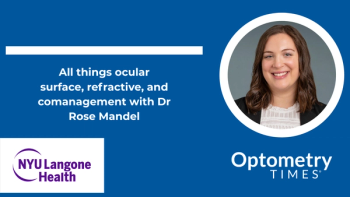
Offer IPL as a treatment for MGD and dry eye disease
Optometric applications of IPL
IPL is one of the most popular cosmetic procedures for treating facial skin conditions, but new applications of the technology are emerging in optometry. Chief among these is the use of IPL to treat meibomian gland dysfunction (MGD),
IPL stimulates facial tissue through controlled light pulses, usually used to target chromophores in the melanin or blood. The light emitted during an IPL procedure is absorbed by the oxyhemoglobin, creating heat and coagulating the vessel to reduce its appearance below the skin.
“IPL is broad spectrum; it’s non-monochromatic, non-coherent,” Dr. McGee says.
Modern IPL devices offer
Given that there are over 80 million Americans living with some type of venous disorder, 80 percent of which are cosmetic, it is clear why IPL has seen so much success in cosmetic dermatology.1
According to Dr. McGee, IPL shows promise in the treatment of more confounding optometric conditions-such as MGD and DED.
Managing dry eye with IPL
As ODs know, MGD is a chronic, diffuse abnormality of the meibomian glands resulting in reduced tear film quality, inflammation, and
“It is a progressive disease,” Dr. McGee says.
The link between rosacea and MGD is well established, with 80 percent of rosacea patients suffering from symptoms of MGD.2-5
Although MGD is complex and multifactorial, MGD arises from a combination of these conditions:
• Primary obstructive hyperkeratinisation
• Abnormal meibomian secretion
• Eyelid inflammation
• Corneal conjunctival inflammation
• Epithelial damage
• Ocular bacteria
“It’s a vicious cycle,” Dr. McGee says.
When one of these symptoms appears, it tends to create additional complications that make the overall condition harder to treat. However, IPL offers a comprehensive approach.
“When you look at intense pulsed light, it hits all six,” she says.
IPL treatment
Although IPL has applications in optometry, it is a new treatment modality that ODs will need to explore and understand. IPL’s light stimulation can produce unintended side effects when handled improperly.
The primary concern is selecting the appropriate wavelength of light to adequately treat the patient.
“When we are performing IPL, we have to look at how to type the skin,” Dr. McGee says.
ODs should use the Fitzpatrick Scale to determine which level of light energy is safe for various skin types.
They can adjust the IPL treatment’s light energy, wavelength, pulse rate, and pulse duration to account for the patient’s physical characteristics and medical condition. ODs must adjust the IPL therapy to ensure that the right amount of energy is delivered to the right location at the right time.
While patients usually experience itching and irritation at the treatment site after therapy, the tools themselves contain safeguards to prevent undue exposure.
“Different filters block anything below a particular wavelength,” Dr. McGee says.
However, light energy isn’t the only concern. Dr. McGee says that other contraindications may make a patient unsuitable for an IPL treatment.
• Presence of visible lesions, cold sores, or dysplastic nevi
• Melasma
• Active infections
• Certain drugs (such as Accutane [isotretinoin])
• Visible tan or excess melanin
Pre-treatment education
Part of managing MGD, both with IPL and through traditional therapies, involves educating the patient and establishing expectations.
“You have to teach your patients that this a chronic disease,” Dr. McGee says.
Treatment of MGD is a step-by-step approach that will, ideally, result in returning the front surface of the eye back to a state of homeostasis. This process always takes time, even with more modern therapies like IPL.
Dr. McGee says that IPL therapies are usually performed in three to five sessions spaced across weeks or months. Six-month or annual maintenance appointments may be necessary for continued results, depending on the patient.
There is no silver bullet solution for curing MGD or dry eye, but IPL marks an important milestone in treatment opportunities.
“To have another tool in our arsenal that treats all six of those pieces is pretty exciting,” Dr. McGee says.
Diagnosing dry eye
Before IPL treatment can begin, ODs must make sure that they know what they are treating and the extent of the condition, when possible. What may appear to be DED may be something else entirely.
“A lot of things can mimic
She advises that ODs take a methodical, step-by-step approach to uncovering potential challenges during the early stages of the patient’s examination. Generally, it is to the benefit of both the provider and patient to keep things simple and straightforward. Dr. McGee recommends several tools to use when making an assessment:
• Standardized Patient Evaluation of Eye Dryness (SPEED) questionnaire
• Ocular Surface Disease Index (OSDI) questionnaire
• Medical history/medication use
• History of contact lens wear
• Lid seal and physical assessment
• Makeup use and composition
A system that uncovers which patients may have MGD or dry eye symptoms-even when they are seen for other complaints-is crucial, Dr. McGee says.
“Keep it simple, ask the right questions, look at a risk factor analysis, get through diagnostics, then classify and treat the disease,” she says.
References:
1. American Vein & Lymphatic Society. Patient Brochure. Available at: https://www.phlebology.org/wp-content/uploads/2014/10/Varicose_Vein_Brochure_Sample.pdf. Accessed 11/14/19.
2. Chamaillard M, Mortemousque B, Boralevi F, Marques da Costa C, Aitali F, Taïeb A, Léauté-Labrèze C. Cutaneous and ocular signs of childhood rosacea. Arch Dermatol. 2008 Feb;144(2):167-71.
3. Cetinkaya A, Akova YA. Pediatric ocular acne rosacea: long-term treatment with systemic antibiotics. Am J Ophthalmol. 2006 Nov;142(5):816-21.
4. Shiffman RM, Walt JG, Jacobsen G, Doyle JJ, Lebovics G, Sumner W. Utility assessment among patients with dry eye disease. Ophthalmology. 2003 Jul;110(7):1412-9.
5. Mertzanis P, Abetz L, Rajagopalan K, Espindle D, Chalmers R, Snyder C, Caffery B, Edrington T, Simpson T, Nelson JD, Begley C. The relative burden of dry eye in patients’ lives: a comparison to a US normative sample. Invest Ophthalmol Vis Sci. 2005 Jan;46(1):46-50.
Newsletter
Want more insights like this? Subscribe to Optometry Times and get clinical pearls and practice tips delivered straight to your inbox.



















































.png)


